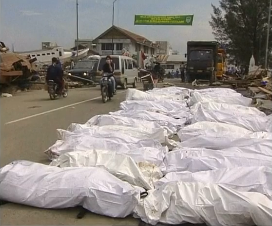
Ten years after the deadly December 26, 2004 Indian Ocean earthquake that triggered a massive tsunami, many communities are still feeling its effects.
On December 26, 2004, a magnitude 9.15 earthquake off the coast of Indonesia’s Aceh province triggered an Indian Ocean tsunami that killed an estimated 226,306 people in Indonesia, Sri Lanka, India, Thailand and nine other countries.
The tsunami garnered an enormous international response, with an estimated $13.6 billion in official aid and private donations pledged for the recovery.
In 2009, the United Nations told governments in Asia’s most catastrophe-prone areas they should set aside 10 percent of their development funds to limit the risk of disaster, especially given the impact of climate change.
Indonesia’s northern province of Aceh bore the brunt of the disaster, where a total of 128,858 people were killed, according to statistics compiled by government and aid agencies.
572,926 people were displaced and 179,312 buildings and homes destroyed in Indonesia alone as the wave swallowed up large parts of the coastline.
Day by day, the death toll rose, as bodies littered the streets, waiting to be collected, and others continued to wash ashore, decaying among piles of debris.
Hospitals and morgues struggled to cope with injured and bewildered victims and bloated corpses.
Aid deliveries to Aceh were hindered due to lack of fuel, impassable roads, downed bridges, and damaged air strips. Military and private transport aircraft, however, were quickly able to fly directly to Aceh’s battered provincial capital Banda Aceh.
Many survivors from isolated villages had to walk for days to Banda Aceh to receive food, aid and information about their relatives.
Although the international response to the disaster was unprecedented, with an estimated $13.6 billion official aid and private donations pledged for recovery in the 13 countries affected, 10 years later, many communities still feel the affects of what remains the deadliest tsunami on record. (Reuters)







